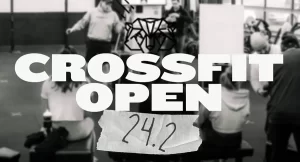Make the most of your Ring dips
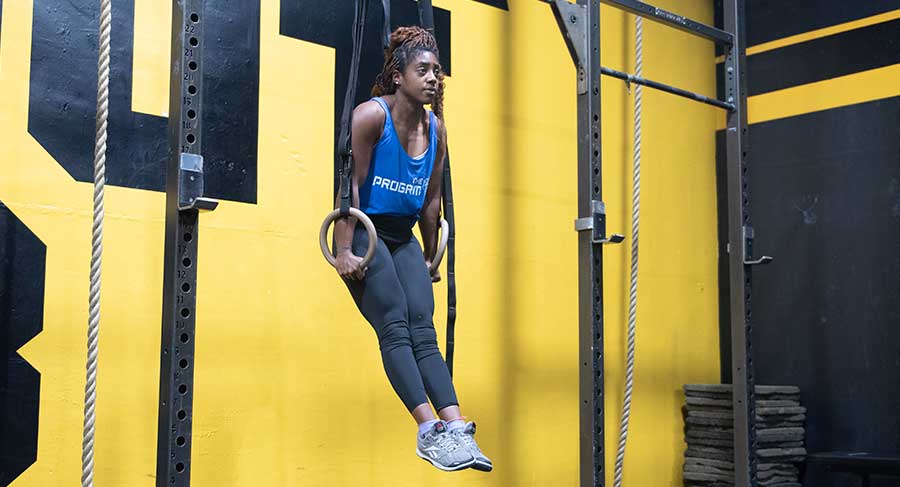
Like many bodyweight movements in CrossFit, the ring dip is often overlooked. After reading this article, not only will you come to understand the advantages of adding more dips to your training, you’ll gain the tools you need to get your first strict dip on the rings.
What is a Ring Dip?
A dip is an upper-body pressing exercise in which the athlete must lower and raise themselves with their hands supported in line or slightly behind their body. This fundamental bodyweight movement is essential for developing upper body strength and contributes toward learning more advanced exercises.
The set up
Set your rings at shoulder-width apart. Take the rings with a full grip; rings held in your palms, thumbs wrapped around and wrists should be almost straight.

Start in a support hold position:
- With straight arms, use your shoulders to push down into the rings.
- Your hips should be under your shoulders.
- Keep your core and quads activated.
- Point your toes and keep them slightly ahead of your hips.

- Begin to bend at the elbows while keeping your shoulders compressed down.
- As you lower your body, send your elbows back and let your chest drop forward slightly.
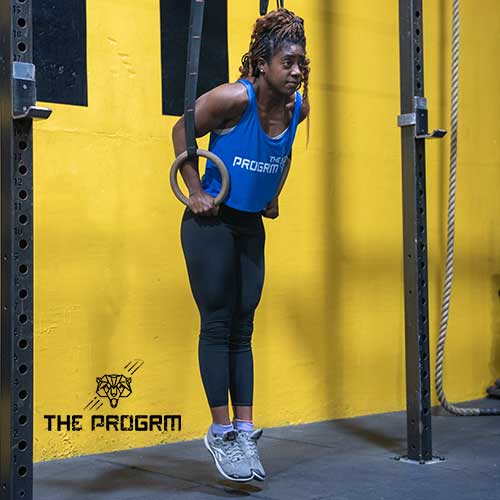
- Keeping the rings close to your body, descend until your shoulders are lower than your elbows before extending returning to support hold.
- You should be able to move through the range of the exercise while maintaining posture and tension.

What are the benefits of Ring dips?
The dip is a compound movement, meaning that it trains several muscle groups at once. Generally, dips strengthen the chest, shoulders, back, and arms but you can target each of these specific zones by changing the position and distance of your hands when performing the exercise.
The main muscles worked are the triceps, pecs, anterior deltoids, and rhomboids.
Development of these muscles can help to safe-guard your shoulders and surrounding joints which is all too needed for most CrossFit athletes.
Additional benefit comes from using gymnastics rings to perform your dips.
The rings’ lack of stability challenges your balance and body control.
Your abdominals and glutes are also activated to provide stability as you perform the exercise.
Mastering ring dips is essential if you hope to work towards more advanced gymnastics movements that are also used in CrossFit like the ring muscle up.
What’s the difference between static and ring dips?
Dips can be performed on a static surface, such as boxes, chairs, or dip bars. This means that besides being accessible to various levels of athlete, the dip is an exercise that can be practised in the gym, outdoors, or at home.
Dips can also be performed on gymnastic rings, as is typically the case in CrossFit. Unlike boxes or dip bars, rings are hung from a rig or the ceiling by straps. This makes performing dips on the rings a lot more difficult because it is up to the athlete to keep the rings in place as the perform the exercise.
There are different variations for performing dips, some of which can be tougher than others.

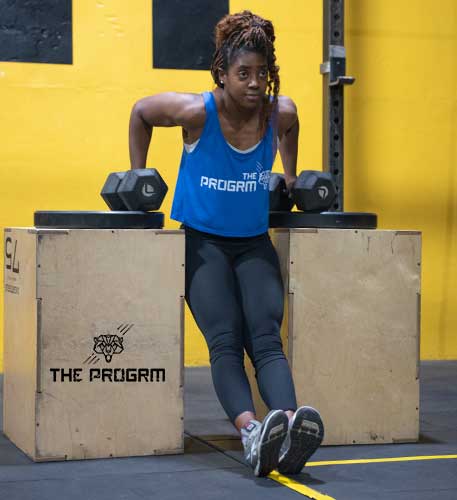
How should I approach learning Ring Dips?
Like many bodyweight exercises, it may take some time perfecting scaled versions before being able to Rx it.
Before attempting dips on the rings, make sure that you can do dips on a fixed surface with little or no support from your lower body.
Using dip bars or two boxes, you should be able to press out from a 90° dip (lowering yourself with control until your elbows form a 90-degree angle) with your feet off the ground and your hips and legs under your torso.
If you can perform at least five solid reps, you’re ready to start working on the rings.
If not, it’s probably necessary that you develop your foundational strength by performing dips with heel or toe support. Apply the same progression below but on a fixed surface until you’re able to meet the minimum strength requirement.
Here are some progressions that you can use to get your first strict ring dip. These exercises can also be used as accessory pieces to help you improve your capacity if you already have them:
Ring Support Hold
Let’s start by perfecting the start and finish for you dips.
Jump into the top position of the rings with your arms straight. Bring your ribcage down toward your pelvis and tuck your hips to maintain hollow body position.
Externally rotate your shoulders slightly and keep your hands close as if they were in your pockets. Hold this position staying as active as possible in the glutes, abs, shoulders and quads.
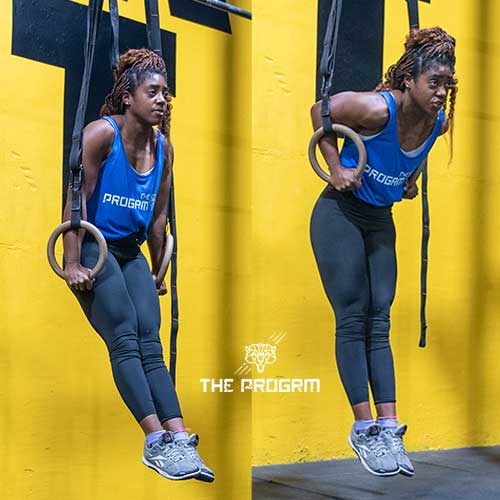
Scale this movement by lowering the rings so that you can keep one foot on the ground. Having this point of contact with the ground makes the exercise easier by redistributing your body weight so that it’s only being supported by your arms. Little by little remove the grounded foot until you can support yourself in the rings alone.
Work up to sets up 20 to 30 seconds before incorporating the other progressions.
Dips with Heel Support
This drill will reinforce the mechanics of a full ring dip despite a lack of strength. With the help of additional support from your feet, you will be able to achieve full depth. Focus on keeping the rings close as you ascend and maintaining good posture throughout.
Set a box or bench about half a metre in front of your rings. Come to the support hold position, place your heels on the box. Complete your reps as you would if you were suspended in the air. Make it more challenging by crossing your ankles, supporting yourself with only one heel. Still too easy? Use only your toes on the edge of the box to support yourself.

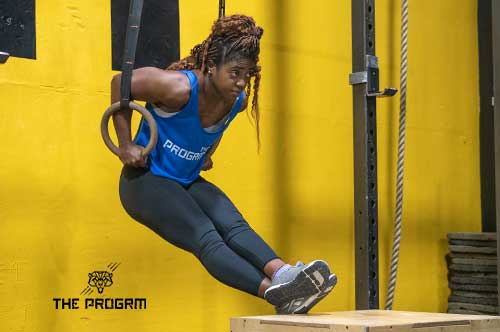
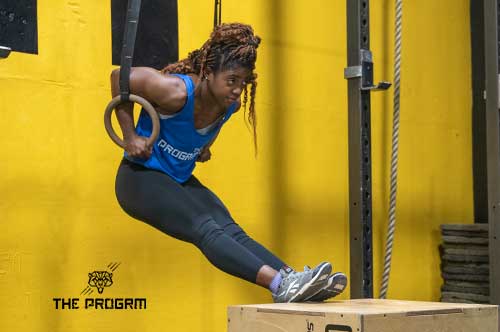
Dip Negatives
Building time under tension is a great way to develop the strength and mechanics needed to perform the complete exercise. With this drill you will practice initiating the lowering phase and maintaining tension in the hole, the most vulnerable part of the ring dip.
Start in a ring support hold. Begin the lowering phase of the dip descending as slowly and controlled as possible. When you reach the lowest point possible without falling or losing control, return your feet to the ground to finish the rep.
How do I use Ring Dips in the WOD?
When ring dips show up in a WOD, the go-to movement is a kipping ring dip.
Kipping isn't necessarily better, but it is highly efficient and very handy in a WOD when done correctly.
Kipping uses momentum generated by your lower body to help your upper body lock out the rep (like a kipping handstand push up or push press).
This can help you to execute more reps before reaching muscular fatigue when compared to strict ring dips.
That said, it's important that you can perform strict ring dips to ensure that your muscles and joints can handle the speed and volume of the kipping variation.
How can I get better at Ring dips?
Practice. Like most other strength exercises, it’s enough to be strong enough, but you have to learn how to execute the movement correctly. Once the performance points are solid, focus on accumulating volume. When you can do multiple sets of 12 or 15 reps, challenge yourself further by using pauses, tempo, and weight. Aim to incorporate ring dips into your training two to three times a week to see steady progress.
Prioritize the quality, positioning, and depth of your ring dips and you’ll be working towards higher skill movements in no time!





